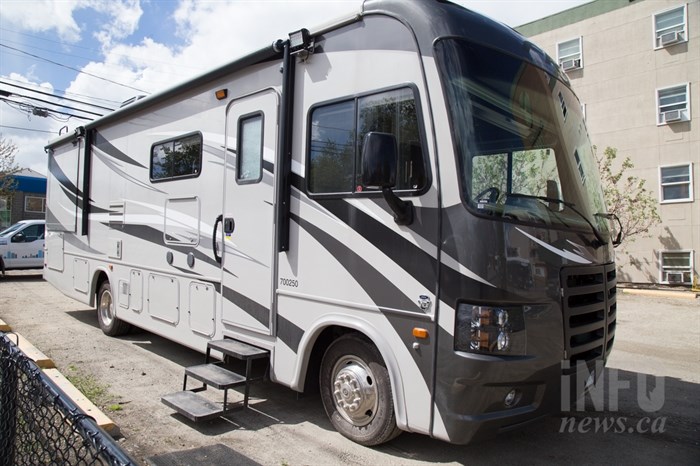
The supervised consumption site in Kamloops.
Image Credit: FILE PHOTO
September 27, 2017 - 9:00 PM
Now that Health Canada will allow people to use the pill or powdered from of illegal drugs at the supervised consumption sites in Kamloops and Kelowna, Interior Health is hoping more drug users will take advantage of the safer space.
Last week, Health Canada approved intranasal and oral drug consumption at the two supervised mobile units in Kamloops and Kelowna, which basically means users can now take pills and snort substances inside the units.
Interior Health Chief Medical Officer Dr. Trevor Corneil says the expansion of services will be a learning experience for the health authority.
“Right now, we’re four months into actually having experience with the supervised consumption service, so I think adding in these other routes of ingestion will add another interesting set of situations and cases and examples where we may need to develop new protocol,” Corneil says. “One step at a time is working well for our service.”
Corneil says the majority of the population coming to the supervised consumption sites in both cities have been transient people.
“It just allows a broader population and perhaps a bigger reach in terms of population,” he says. “Certainly more experience will tell us how these sites will work for drawing in the housed population.”
The supervised consumption sites in Kamloops and Kelowna originally operated as overdose prevention sites, so users didn’t actually use in the unit, but could come inside afterward. The Kelowna site opened its doors about six months ago and on busy days can see upwards of 100 people. Corneil says Interior Health has learned a lot since then.
He says as trust builds within the neighbourhoods, people who have a home may be more inclined to use the sites, and in Kelowna, they've already started picking up harm reduction supplies and take-home naloxone kits. As time goes on, Interior Health will revisit the best way to keep these sites going, whether it’s keeping them mobile or leasing a space to address a bigger population.
An issue that’s been affecting not just Interior communities, but communities across the province, is drug paraphernalia being carelessly left in public places. Harm reduction supplies like safe foil, safe needles and disposable plastic pipes are supplied at the supervised consumption sites, but where can they be disposed of?
Corneil says all of the health authority’s access points have places to dispose of these materials, and in Kelowna about 80 per cent of the supplies they hand out are being brought back to them.
“The perception that health authorities are giving out a lot of harm reduction supplies and those are left everywhere is not the case,” he says. “We know 80 per cent is a large amount of material brought in.”
But it’s not the perfect method to calculate how many needles are carelessly discarded in public places. Corneil says the 20 per cent left over is not representative of what’s being seen in public places in Kelowna, which likely means some users are getting their supplies from somewhere else.
"We’re also working with the municipalities and agencies and local businesses to try and determine how best to work collectively… to try and solve the issue of disposing of harm reduction supplies once they’re used," he says.
Corneil says the risk is extremely low for any contact with a used needle, next to zero.
"That said, nobody wants to actually touch or have their child actually touch a harm reduction utensil."
He says it’s important for all community stakeholders to get together and try to address the issue – including users.
“If (users are) not either in acute withdrawal, or right after or during their use, they care a lot about what their community perceives and the safety of other people around them,” he says.
There isn’t a blanket solution that will work for every community in addressing these issues, Corneil says, so each community in the region will be learning and adapting over the next year to find the best solutions to both.
Get caught up on the opioid crisis here.
To contact a reporter for this story, email Ashley Legassic or call 250-319-7494 or email the editor. You can also submit photos, videos or news tips to the newsroom and be entered to win a monthly prize draw.
We welcome your comments and opinions on our stories but play nice. We won't censor or delete comments unless they contain off-topic statements or links, unnecessary vulgarity, false facts, spam or obviously fake profiles. If you have any concerns about what you see in comments, email the editor in the link above.
News from © iNFOnews, 2017